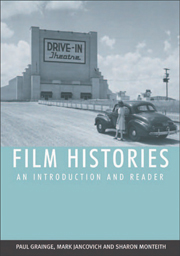Book contents
- Frontmatter
- Contents
- Preface
- Part I Film History from its Origins to 1945
- 1 The Emergence of Cinema
- 2 Organising Early Film Audiences
- 3 Nationalism, Trade and Market Domination
- 4 Establishing Classical Norms
- 5 The Age of the Dream Palace and the Rise of the Star System
- 6 Competing with Hollywood: National Film Industries outside Hollywood
- 7 The Rise of the Studios and the Coming of Sound
- 8 Realism, Nationalism and ‘Film Culture’
- 9 Adjustment, Depression and Regulation
- 10 Totalitarianism, Dictatorship and Propaganda
- 11 The Common People, Historical Drama and Preparations for War
- 12 Wartime, Unity and Alienation
- Part II Film History from 1946 to the Present
- Bibliography
- Copyright Acknowledgements
- Index
9 - Adjustment, Depression and Regulation
from Part I - Film History from its Origins to 1945
Published online by Cambridge University Press: 05 August 2013
- Frontmatter
- Contents
- Preface
- Part I Film History from its Origins to 1945
- 1 The Emergence of Cinema
- 2 Organising Early Film Audiences
- 3 Nationalism, Trade and Market Domination
- 4 Establishing Classical Norms
- 5 The Age of the Dream Palace and the Rise of the Star System
- 6 Competing with Hollywood: National Film Industries outside Hollywood
- 7 The Rise of the Studios and the Coming of Sound
- 8 Realism, Nationalism and ‘Film Culture’
- 9 Adjustment, Depression and Regulation
- 10 Totalitarianism, Dictatorship and Propaganda
- 11 The Common People, Historical Drama and Preparations for War
- 12 Wartime, Unity and Alienation
- Part II Film History from 1946 to the Present
- Bibliography
- Copyright Acknowledgements
- Index
Summary
During the early 1930s, Hollywood faced a series of problems. First, the industry was still adjusting to the introduction of sound and the period saw a series of technical developments in sound recording. Second, the Great Depression followed the Wall Street Crash of 1929, and this seriously affected the industry: as unemployment grew, audiences declined. Finally, opposition to the industry intensified both at home and abroad, and this led to the introduction of the notorious Hays Code in 1934 and the creation of organisations such as the British Film Institute, which were designed to counter the influence of Hollywood overseas.
Although sound created technical problems for filmmakers, its introduction did not significantly change the structure of the industry, which was dominated by eight companies. The ‘Majors’, or Big Five, were Paramount (which had previously been known as Famous Players-Lasky), Loew's (which was better known as Metro-Goldwyn-Mayer or MGM), Fox, Warner Bros. and Radio-Keith-Orpheum (RKO), a new company that had been created in order to capitalise on RCA's sound system. Added to the Majors were three ‘Minors’: Universal, Columbia and United Artists. However, their size did not necessarily imply that these were low-budget enterprises, and United Artists in particular was known for its prestige productions. Much the same is also true of some of the small independent companies, such as those run by Samuel Goldwyn and David O. Selznick, which produced lavish prestige features for the major studios.
- Type
- Chapter
- Information
- Film HistoriesAn Introduction and Reader, pp. 187 - 207Publisher: Edinburgh University PressPrint publication year: 2007



